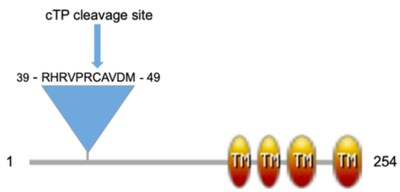Journal:MicroPubl Biol:000867
From Proteopedia

Gossypium hirsutum gene of unknown function Gohir.A03G0737001 encodes a potential Chaperone-like Protein of protochlorophyllide oxidoreductase (CPP1)Alana N. Osborne, Andrew Osagiede, Amanda R. Storm, Amanda M. Hulse-Kemp, Angela K. Stoeckman [1] Molecular Tour Most plants require light for the biosynthesis of the green pigment chlorophyll, which is central to the process of photosynthesis. One of the later steps of the chlorophyll biosynthetic pathway is facilitated by protochlorophyllide oxidoreductase (POR), a light-dependent enzyme[3]. To complete chlorophyll biosynthesis, the POR enzyme must be post-translationally imported into the chloroplast. The chaperone-like protein of POR1 (CPP1) in Arabidopsis has been shown to regulate POR transport and function during this process although its specific role in the process is still unclear[3]. Due to the structural similarity between the J-like domain in CPP1 and the J domain in the DnaJ/HSP70 protein family, it has been suggested that CPP1 has a function similar to the “holdase” chaperone function of the J domain that helps organize interactions with Hsp70 chaperone partners[4]. A functionally conserved His-Pro-Asp (HPD) motif within J-domains facilitates this interaction and, although very similar in structure to the J domain, the HPD motif is absent in J-like domain proteins such as CPP1, indicating these domains may perform a similar molecular function but may have diverged interaction partners. Sequence analysis of GhCPP1-A0A1U8HKT6 indicated it has a N-terminal chloroplast transit peptide with a cleavage site at amino acid 45 along with four predicted TM regions in the C-terminal half of the protein. A domain architecture was created to visualize these sequence features (see static image below and scene ): Interestingly, Arabidopsis thaliana and Nicotiana benthamiana CPP1 proteins are indicated to contain three, not four, TM regions [3]. However, a homolog of Arabidopsis CPP1, At2g20920, has been identified to also contain four TM regions[7] suggesting a potential structural or functional difference between these family members. The (colored in rainbow format with the N-terminus in blue and C-terminus in red) depicts between amino acids 56-119 and 150-254 and a low-confidence modeled region between them from amino acids 119-150 (shown transparent). The predicted TM regions are seen as a 4-helix bundle that exhibits expected (Hydrophobic, Polar). (PDB ID: 2dn9; in deep sky blue) displays a similar anti-parallel hairpin between the horizontally-displayed alpha helices II and III, although the GhCPP1-A0A1U8HKT6 J-like domain lacks the fourth helix of human Tid1 and has a shorter loop. When DALI [8] was used to search for proteins having a similar tertiary structure to the proposed J-like domain of GhCPP1-A0A1U8HKT6, one of the highest similarity hits (Z-score of 7.9 and RMSD score of 1.5) was with the J-like domain of yeast TIM16 that is part of the mitochondrial translocase of the inner membrane protein complex, TIM16/TIM14 (PDB ID: 2guz). The TIM16/TIM14 heterodimer complex serves as a co-chaperone duo, a critical part of the translocase import motor responsible for piloting translocation proteins into the mitochondria[9]. As the biosynthesis of chlorophyll in plants requires the light-dependent enzyme POR1 to be post-translationally imported into the chloroplast, it is possible that the J-like domain found in GhCPP1-A0A1U8HKT6 may allow it to partner with an as yet unknown co-chaperone to function similarly to the TIM16/TIM14 complex, chaperoning the translocation of POR1. This is supported by (in light blue, PDB 2guz) that shows a conserved surface on GhCPP1-A0A1U8HKT6 at the modeled protein-protein interaction site with the TIM14 protein (in dark blue). Evidence from protein sequence, homology, and structure support GhCPP1-A0A1U8HKT6 as a chaperone-like protein of POR1 in Gossypium hirsutum. GhCPP1-A0A1U8HKT6 is predicted to be anchored in the chloroplast membrane where it could interact with POR and support its entry into the chloroplast where chlorophyll biosynthesis occurs, similar to Arabidopsis CPP1 to which it has high sequence similarity. The molecular function of the J-like domain is still unclear. Similarity in structure to the J-domain suggests a similar protein-protein interaction domain function as in the “holdase” activity of molecular chaperones, although the lack of a HPD motif indicates different binding partners. This is supported by the J-like domain in mitochondrial TIM16 being part of a heterodimer complex. It would be interesting for further studies to explore potential binding partners of GhCPP1-A0A1U8HKT6. References
| |||||||||||

